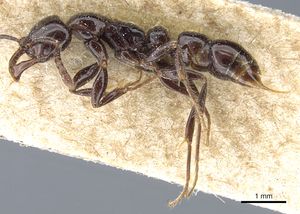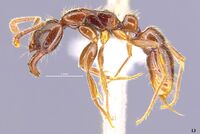Myopias bidens
| Myopias bidens | |
|---|---|

| |
| Scientific classification | |
| Kingdom: | Animalia |
| Phylum: | Arthropoda |
| Class: | Insecta |
| Order: | Hymenoptera |
| Family: | Formicidae |
| Subfamily: | Ponerinae |
| Tribe: | Ponerini |
| Genus: | Myopias |
| Species: | M. bidens |
| Binomial name | |
| Myopias bidens (Emery, 1900) | |
| Subspecies | |
| |
Mature colonies of most Myopias species are small (>100 workers). Myopias bidens is the one exception. Jaitrong, Tasen and Guénard (2018) reported finding nests of this ant in heavily decomposed, rotten wood that contained up to a thousand workers.
Identification
Jaitrong, Tasen & Guénard (2018) - Body 5.10–5.50 mm in total length (small size). Masticatory margin of mandibles with four teeth; median clypeal lobe about as long as broad, squared, its anterior margin distinctly concave; eyes relatively small with 5–6 ommatidia along the longest axis; antennal scape relatively short, not reaching posterior margin of head; petiole in profile subrectangular, almost as long as high; subpetiolar process subtriangular, located anteroventrally, its apex truncate and pointed downward. Entire body (head, mandible, antennal scape, mesosoma, legs, and metasoma) smooth and shiny except for lower portion of lateral face of propodeum finely striate. Body entirely reddish brown to yellowish brown, head darker than elsewhere.
Thailand Myopias species: Myopias bidens is similar in general appearance to Myopias breviloba, Myopias castaneicola, Myopias mayri and Myopias trumani in having the following characteristics in the worker: masticatory margin of mandibles with conspicuously produced basal angle followed by a distinct concavity; masticatory margin blade between basal angle and prebasal tooth subequal in length to distance between prebasal tooth and apical tooth; median clypeal lobe with concave anterior margin, anterolateral corners conspicuously dentate; head smooth and shiny. However, this species is most similar to M. breviloba in having large compound eyes, with maximum diameter being longer than malar space length (eyes reduced, with maximum diameter being shorter than malar space length in M. castaneicola, M. mayri and M. trumani). It is separated from M. breviloba by the condition of the median clypeal lobe that has the median lobe length subequal to its width, while the medial lobe is clearly shorter than wide in M. breviloba; body colour is reddish brown to dark brown in M. bidens, while body colour is paler in M. breviloba.
Keys including this Species
Distribution
Tak, Chanthaburi and Narathiwat Provinces, Thailand; Sumatra, Indonesia.
Latitudinal Distribution Pattern
Latitudinal Range: 15.3247222° to 6.07277778°.
| North Temperate |
North Subtropical |
Tropical | South Subtropical |
South Temperate |
- Source: AntMaps
Distribution based on Regional Taxon Lists
Indo-Australian Region: Indonesia (type locality), Philippines.
Oriental Region: Thailand.
Distribution based on AntMaps
Distribution based on AntWeb specimens
Check data from AntWeb
Countries Occupied
| Number of countries occupied by this species based on AntWiki Regional Taxon Lists. In general, fewer countries occupied indicates a narrower range, while more countries indicates a more widespread species. |

|
Estimated Abundance
| Relative abundance based on number of AntMaps records per species (this species within the purple bar). Fewer records (to the left) indicates a less abundant/encountered species while more records (to the right) indicates more abundant/encountered species. |

|
Habitat
Jaitrong, Tasen & Guénard (2018) - Myopias bidens is distributed from lowland to highland in various types of forests (swamp forest, evergreen forest, dry evergreen forest and hill evergreen forest) and within both primary and secondary forests.
Biology
Castes
Worker
       
| |
| . | |
Nomenclature
The following information is derived from Barry Bolton's Online Catalogue of the Ants of the World.
- bidens. Trapeziopelta bidens Emery, 1900c: 313 (diagnosis in key) (w.) INDONESIA (Sumatra).
- Type-material: holotype worker.
- Type-locality: Indonesia: Sumatra, Si Rambé (E. Modigliani).
- Type-depository: MSNG.
- [Also described as new by Emery, 1900d: 664.]
- Combination in Myopias: Bolton, 1995b: 269.
- Status as species: Emery, 1911d: 93; Chapman & Capco, 1951: 75; Bolton, 1995b: 269; Xu, Burwell & Nakamura, 2014b: 166 (in key); Probst, Guénard & Boudinot, 2015: 204 (in key); Jaitrong, Tasen & Guénard, 2018: 154 (redescription).
- Distribution: Indonesia (Sumatra), Thailand.
- Current subspecies: nominal plus polita.
Unless otherwise noted the text for the remainder of this section is reported from the publication that includes the original description.
Description
Worker
Jaitrong, Tasen & Guénard (2018) - Non-type workers (n = 15): TL 5.10–5.50, HL 0.96–1.06, HW 0.79–0.96, SL 0.69–0.86, ED 0.10–0.13, ML 0.66–0.76, PW 0.56–0.63, MSL 1.39–1.52, PL 0.36–0.46, PH 0.46–0.53, DPW 0.40–0.43. CI 83– 91, SI 88–90, OI 12–15, MI 69–72, LPI 114–127, DPI 100–109.
Type Material
Jaitrong, Tasen & Guénard (2018) - Holotype worker, INDONESIA, Sumatra, Si-Rambé, Museo Civico di Storia Naturale, Genoa, AntWeb image examined.
References
- Bolton, B. 1995b. A new general catalogue of the ants of the world. Cambridge, Mass.: Harvard University Press, 504 pp. (page 269, Combination in Myopias)
- Emery, C. 1900b. Formicidarum species novae vel minus cognitae in collectione Musaei Nationalis Hungarici quas in Nova-Guinea, colonia germanica, collegit L. Biró. Publicatio secunda. Természetr. Füz. 23: 310-338 (page 313, (diagnosis in key) worker described)
- Emery, C. 1900d. Formiche raccolte da Elio Modigliani in Sumatra, Engano e Mentawei. [part]. Ann. Mus. Civ. Stor. Nat. 40[=(2(20): 661-688. (page 664, also described as new, fig. 2)
- General, D.E.M., Buenavente, P.A.C., Rodriguez, L.J.V. 2020. A preliminary survey of nocturnal ants, with novel modifications for collecting nocturnal arboreal ants. Halteres 11: 1-12 (doi:10.5281/ZENODO.3707151).
- Ito, F., Nguyen, D.A., Eguchi, K., Toyota, A., Billen, J. 2020. Colony composition, queen behavior, specialized predation on millipedes, and exocrine glands in the ponerine ant Myopias conicara Xu, 1998 (Hymenoptera: Formicidae). Entomological Science 23, 142–151 (doi:10.1111/ens.12406).
- Jaitrong, W., Tasen, W., Guénard, B. 2018. The ant genus Myopias Roger, 1861 (Hymenoptera: Formicidae: Ponerinae) in Thailand, with descriptions of three new species. Zootaxa 4526:151–174 (DOI 10.11646/zootaxa.4526.2.3).
References based on Global Ant Biodiversity Informatics
- Chapman, J. W., and Capco, S. R. 1951. Check list of the ants (Hymenoptera: Formicidae) of Asia. Monogr. Inst. Sci. Technol. Manila 1: 1-327
- Emery C. 1900. Formicidarum species novae vel minus cognitae in collectione Musaei Nationalis Hungarici quas in Nova-Guinea, colonia germanica, collegit L. Biró. Publicatio secunda. Természetrajzi Füzetek 23: 310-338.
- Emery C. 1911. Hymenoptera. Fam. Formicidae. Subfam. Ponerinae. Genera Insectorum 118: 1-125.
- Emery C. Formiche raccolte da Elio Modigliani in Sumatra, Engano e Mentawei. Annali del Museo Civico di Storia Naturale 40: 661-722.
- Emery, C. "Formiche raccolte da Elio Modigliani in Sumatra, Engano e Mentawei." Annali del Museo Civico di Storia Naturale Giacomo Doria (Genova) (2) 20, no. 40 (1900): 661-722.
- Jaitrong W., W. Tasen, and B. Guénard. 2018. The ant genus Myopias Roger, 1861 (Hymenoptera: Formicidae: Ponerinae) in Thailand, with descriptions of three new species. Zootaxa 4526: 151–174.
- Wheeler W. M. 1937. Additions to the ant-fauna of Krakatau and Verlaten Island. Treubia 16: 21-24.
- Xu Z.-H.; C. J. Burwell., and A. Nakamura. 2014. A new species of the ponerine ant genus Myopias Roger from Yunnan, China, with a key to the known Oriental species. Sociobiology 61(2): 164-170.

